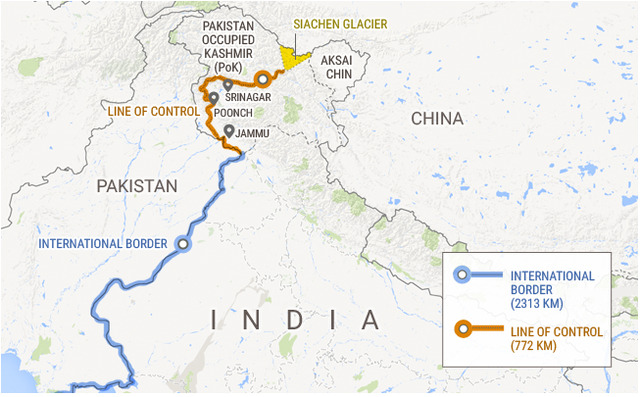Background
As per the Treaty on the Non-Proliferation of Nuclear Weapons (NFT) of 1970, there are five designated nuclear weapon states — the United States, Russia, the United Kingdom, France and China — who also serve as the five permanent members of the UN Security Council. However, in 1974, four years following the enactment of the NFT, India conducted its first successful nuclear bomb test: Pokhran-I or Operation Smiling Buddha. Characterized by India’s Ministry of External Affairs as a “peaceful nuclear explosion,” the test presented new challenges to the growing sphere of nuclear politics. Being the first country outside of the five sanctioned nuclear states, India’s possession of nuclear weapons drew concerns in the international community, but these revelations were the most worrisome for India’s Western neighbor and long-time adversary, Pakistan. After India followed up with Pokhran-II, a second round of nuclear tests, over two decades later, Pakistan soon responded with its own public tests of nuclear weapons, Chagai-I on May 28, 1998, and Chagai-II just two days later.
The testing of India and Pakistan’s nuclear capabilities in May 1998 sparked the beginning of nuclearization in South Asia, which remains one of the primary security issues in the region today. The Indian subcontinent is the most likely venue for nuclear conflict, and with recent developments, notably India’s completion of the Nuclear Triad in 2018, enabling nuclear deterrence by land, air and sea, their proposed “Cold Start Doctrine, along with Pakistan’s development of tactical nuclear weapons, the threat is only evolving.
While two additional powers possessing nuclear weapons are concerning enough, the contentious relationship between the two countries augments those worries. Since independence and partition in 1947, India and Pakistan have been engaged in four large-scale military conflicts and maintain hostile political and military postures toward one another. With many key points of conflict unresolved, the potential for another military confrontation takes on a heightened dimension with the prospect of nuclear war. There are two key questions: Where do India and Pakistan stand with respect to nuclear weapons? And does nuclearization serve to stabilize or fuel instability in the ongoing protracted conflict between the two adversaries?
Doctrine, Deterrence, and the Stability-Instability Paradox
Since the United States dropped two nuclear bombs on Japan during World War II, the resulting destruction has instilled a universally accepted taboo against using any kind of nuclear weapon. In other words, “[t]here has been a clear and abiding sense that the use of any nuclear weapon would be a strategic act, one that would fundamentally change the nature of the conflict in which the weapon had been used.”As a result, most countries possessing nuclear weapons have adopted a nuclear doctrine, which serves as their rules of engagement on the employment of nuclear weapons directed at potential adversaries.
The doctrine is critical for establishing a country’s deterrence posture, which signals to adversaries that any potential action they may pursue will not succeed or go unpunished. Where full nuclear disarmament is not viable, policymakers and military leaders aim to achieve “strategic stability,” an equilibrium state where neither country feels threatened by the other or perceives a significant disadvantage. Successful nuclear deterrence has the power to induce strategic stability, meaning that when two countries each have nuclear weapons, if deterrent postures and doctrines are “reciprocally credible” enough to each of the adversaries, the likelihood of direct war is unlikely. However, the presence of nuclear weapons can also erode this stability by encouraging minor conflicts. This logic is what is called the “stability-instability paradox.”
Many scholars believe that the “stability-instability paradox” applies to the South Asia context. Rather than seeking strategic stability, many states “seek to increase imbalances between them to better play to their national advantages and more likely to prevail over the other in certain non-nuclear conflicts.” This is the case with India and Pakistan. There has been evidence of increased Pakistani aggression towards India by way of terrorist organizations and insurgents, which Michael Krepon theorizes has “notably coincided with its acquisition of nuclear capabilities.”This satisfies the instability condition of the paradox that possessing nuclear weapons increases the likelihood of proxy wars and other minor conflicts.
The other condition is also relevant to the India-Pakistan example. In 1999, a year after both powers conducted public nuclear tests, India and Pakistan were involved in a military conflict in Kargil. Despite the severity of the conflict and both being nuclear powers, neither country employed nuclear weapons. Although this is not a promise of future restraint in the event of conflict, this signifies that a degree of nuclear deterrence has been achieved, enough to promote strategic stability.
However, others argue that the stability/instability paradox does not explain the nature of conflict in nuclearized South Asia. They theorize a different strategic environment in which “instability in the nuclear realm encourages instability at lower levels of conflict.”This perspective characterizes the India-Pakistan relationship as “aggressive Pakistani attempts to revise territorial boundaries in the region” and “relatively restrained Indian efforts to preserve the status quo.”
Even with these attempts, Pakistani policymakers are astutely aware of Pakistan’s conventional insecurity vis-à-vis India; in the event of war, while they may enjoy an advantage in the initial stages of a conventional conflict with India, in a protracted conflict, India would decisively prevail. Given this, if there was a high degree of strategic stability and both sides understood that the probability of nuclear use was low, it would be challenging for Pakistani leaders to credibly threaten nuclear weapon employment. This reduction in deterrence would encourage caution on Pakistan’s end – they would face strong incentives to not engage in aggressive behavior. In other words, Pakistani adventurism is promoted when nuclear escalation as a serious possibility: the likelihood of a limited-scale confrontation between India and Pakistan has a high chance of spiraling into a full-scale conventional conflict employing nuclear weapons.The stability-instability paradox is replaced with an instability-instability relationship.
With all of this in mind, these various theoretical lenses provide a strong foundation in understanding India and Pakistan’s nuclear doctrines. It also helps understand how recent developments reflect the countries’ perceptions and attitudes towards each other politically and militarily.
India and Pakistan’s Nuclear Doctrine
Through press releases and other public statements, scholars have developed a clearer understanding of India and Pakistan’s nuclear doctrines. A key component of India’s doctrine is its policy of “no first use” (NFU) of nuclear weapons against all nuclear-armed states, meaning they will never initiate a nuclear first strike. However, they maintain a strong commitment to retaliate at a massive scale in response to any serious attacks designed to cause “unacceptable damage.” India has not included any provisions of graduated escalation and has not publicly named any potential adversaries, although Pakistan and China present as clear contenders. India revisits its doctrine periodically, but it has not been formally revised since 2003.
Pakistan, on the other hand, has a policy of “full-spectrum deterrence” (FSD), designed to “prevent conventional conflict at any level by the threat of nuclear first use in response to aggression.” Even without a policy of no first use, Pakistan would likely only resort to nuclear use in response to a large-scale attack. Full-spectrum deterrence includes both short, range low-yield weapons and long-range weapons that targets all parts India’s vast territory, which they have named as their sole adversary. Inflicting unacceptable damage is intrinsic to the full-spectrum method. Still, the threat of short-range weapon use is specifically meant to deny India in the event of limited conventional war.
India and Pakistan’s nuclear doctrines bear several similarities. Neither doctrine suggests preemption using nuclear weapons or utilizing a disarming first strike. There is also no explicit discussion of either counterforce targeting, which refers to targeting an opponent’s military infrastructure, or counter-value targeting, which involves targeting an opponent’s non-military assets, like cities and civilian populations. They implicitly opt for the latter; however, in Pakistan’s case, they also have not entirely discounted military targets. Both doctrines refer to the existence of a second-strike capability, which includes developing strong retaliatory measures to exact “unacceptable damage” while also emphasizing the importance of completing the nuclear triad by acquiring sea-based capabilities. More broadly, both doctrines reference command and control, fostering resiliency, and pursuing peace to prevent nuclear escalation.
The glaring difference between the two doctrines is the contrasting positions on first-strike capability. Pakistan’s lack of no first use has been worrying for Indian military leaders and policymakers; however, the asymmetry of the two doctrines is not surprising, given the stark differences in the strategic dynamics at play in each country.Pakistan is not India’s only potential adversary; in fact, India’s motivation for nuclear armament was to deter a nuclear-armed China. They categorically deny that they sought nuclear weapons solely for prestige; in their view, they are pursuing their own self-preservation. On the other hand, Pakistan’s sole threat is India, and the country’s conventionally inferior military position vis-à-vis their eastern neighbor drove their motivations to compensate for that imbalance through nuclear means.
Nuclear Forces in South Asia
Even with their nuclear doctrines, India and Pakistan discuss their nuclear weapons programs with “pervasive secrecy” and “intentional ambiguity”.However, it is evident that both countries intend to grow their weapons holdings, with a few concerning developments. Previously, both countries were believed to store their nuclear weapons in “de-mated” status, with the warheads detached from their delivery systems so they are not fully assembled. This storage method reduces the likelihood of unauthorized launch or theft of a usable nuclear device. This barrier is being eroded, largely due to “perceived imperatives for greater readiness” and other recent trends, like putting missiles in ready-to-fire canisters and Pakistan’s development of tactical nuclear weapons.
Both countries’ weapons programs consist of a mix of gravity bombs and ballistic missiles for delivery, as well as a sufficient number of cruise missiles on Pakistan’s side. Both India and Pakistan seem to have diverged from the weaponry employed by the United States and the Soviet Union during the Cold War, such as nuclear artillery shells, landmines, torpedoes, and depth charges. Yet, both countries’ existing and projected arsenals have the potential to inflict “unacceptable damage” without any assurance of preventing a second strike or ending a potential nuclear conflict. India and Pakistan also prioritize protecting their nuclear weapons and their components to promote deterrence stability in the absence of a clear dialogue or framework between the two countries about the consequences of an attack. Details of security arrangements, however, are limited, with most information coming from the government agencies themselves.
Pakistan relies predominantly on ground-based ballistic missiles, but with expansion into air-launched and ground-launched cruise missiles. While serving counterforce purposes against military targets, these missiles have the potential to hit any Indian city if they choose to adopt a counter-value strategy, implicitly supported by their doctrine. There are two Pakistani nuclear-delivery systems of profound importance due to their respectively very short and very long ranges. The Nasr missile system is comprised of four missile canisters on a wheeled transporter erector launcher. This can deliver a conventional or nuclear warhead to a range of 60-70 km.From a power projection standpoint, the development of tactical nuclear weapons, such as this, functions as an antidote to India’s “Cold Start” doctrine, which is designed to seize Pakistani territory “swiftly” without escalation into nuclear conflict. The former head of Pakistan’s Strategic Plans Division (SPD), Lieutenant General (retired) Khalid Kidwai noted that these weapons were developed “in response to concerns that India’s larger military could still wage a conventional war against the country, thinking Pakistan would not risk retaliation with a. bigger nuclear weapon.”
There are a few key problems that come with the Nasr system. This system presents the possibility that Pakistan could use nuclear weapons well before any existential threat for signaling purposes. There is also the “use it or lose dilemma”: Pakistani military leaders fear that they may lose precious nuclear assets to mishap or enemy attack before they have the chance to be used, further incentivizing their deployment. Beyond increasing Pakistan’s arsenal size, the dual capacity of this system (conventional and nuclear) leads to the discrimination problem: “How would Pakistan react if Indian forces, intentionally or not, attacked a Nasr battery?” Although India would not definitively know what type of warhead the Nasr was carrying, Pakistani leaders may perceive this as an “attack on the country’s strategic assets” and retaliate. In contrast, the Shaheen-3 ballistic missile has an extremely long range of over 2,750 km.
This missile form was developed due to reports of India potentially basing active nuclear missiles at a test site in the Andaman and Nicobar Islands in the Indian Ocean or Pakistani suspicion about an India-Seychelles Agreement to develop a naval facility on Assumption Island. Although nothing has been constructed on either site as of now, with several other potential counterforce and counter value targets in mainland India, neither of these island targets seem to be consistent with inflicting “unacceptable damage” for deterrence. The missiles themselves are concerning if turned in the opposite direction: they have the range to strike Israel and other parts of the Middle East, extending as far as Djibouti, home to Chinese and U.S. bases, and the northern Indian Ocean region.
For India, gravity bombs delivered via aircraft are prominent in their nuclear arsenal, but their portfolio of missiles for nuclear delivery is growing. Although less diverse than that of Pakistan, there are various medium-range systems for use against Pakistan and longer-range options for Chinese targets, along with several dual-purpose cruise missiles. These capabilities reflect key facets of India’s nuclear doctrine to absorb a first strike (survivability) and retaliate at a massive scale. As of now, India has not yet developed a nuclear warhead for a cruise missile, but could work with Russia for versions of the Indo-Russian BrahMos (“Brahmaputra-Moscow”), with a range of 400 km, or the homegrown Nirbhay, with a range of 1,000 km, which is currently being tested.
Unlike Pakistan’s Nasr system, India does not seem to have a short-range, low-yield battlefield nuclear-delivery system. This is not a symbol of inferiority, as developing such a system would be inconsistent with India’s doctrine and their renouncement of the tactical nuclear weapons path. Regardless, by blurring the lines between conventional and nuclear conflict, the development of dual-capability systems presents its own misperception risks.
Key Issues: Kashmir, Jihadi Terrorism, and Countering China
Difficulties in achieving stability between two nuclear-armed states usually stem from underlying political problems. In the case of India and Pakistan, the most glaring example is their dispute over the territory of Kashmir. The Indian view sees the territory as having been a part of India since the Maharaja of Kashmir signed an instrument of accession and joined India in 1947. While the Maharaja was Hindu, Kashmir’s population is largely Muslim — aligned more with the demographic composition of the Muslim-majority nation of Pakistan — and insurgent groups have been operating in Kashmir, backed by Pakistan, advocating for official separation from India. Pakistan, on the other hand, believes that Kashmir’s accession to India was illegal and undemocratic. The Indian government finds that Pakistani support for the Kashmir insurgency and cross-border incursions into Kargil, represent a long history of Pakistani attempts to unlawfully and violently seize its sovereign territory. The Pakistani government argues that India’s continued refusal to hold a plebiscite with regard to accession denies Kashmiris the right to self-determination.
Supporting the insurgency and liberating Indian Kashmir is an integral aspect of Pakistani policy and their relations with India. While India would be willing to accept a permanent division of territory along the Line of Control (LoC), which currently separates Indian and Pakistani Kashmir, Pakistan does not welcome the status quo. As a result, they have been responsible for most of the recent cross-border aggression between the two countries. Pakistan heavily depends on insurgents and terrorist groups, like the Haqqani Network and Lashkar-e-Taiba, operating in the region to “bleed India and coerce Indians into negotiating a diplomatic settlement on Kashmir” and continue to support these groups to achieve this.
However, this poses grave consequences with nuclear weapons in consideration. The most likely source of conflict between the two countries is an Indian land incursion into Pakistan in response to a proxy terrorist attack on India. Indian Army Chief General M.M. Naravane warned that “[i]f Pakistan does not stop its policy if state-sponsored terrorism, we reserve the right to preemptively strike at the sources of terror threat…”Such a strong Indian armed response could paralyze Pakistan to the point of existential threat, whereby first use of nuclear weapons is a very real possibility. This was echoed by Pakistani Lieutenant-General (Retired) Khalid Kidwai: “[Nuclear weapons will be used only] if the very existence of Pakistan as a state is at stake… Nuclear weapons are aimed solely at India. In case that deterrence fails, they will be used if: a) India attacks Pakistan and conquers a large part of its territory (space threshold); b) India destroys a large part either of its land or air forces (military threshold); c) India proceeds to the economic strangling of Pakistan (economic strangling); and d) India pushes Pakistan into political destabilization or creates a large scale internal subversion in Pakistan (domestic destabilization).”Exercising this first strike capability and India’s subsequent retaliatory response will only prove disastrous for the future of the Indian subcontinent.
While Pakistan’s policy is solely focused on India, China is critical in India’s security calculations for both conventional and nuclear conflict. India and China have a long history of border disputes, and India’s 1962 defeat in a border war against China and more recent incidents along the Line of Actual Control in 2013, 2014, 2015, 2017, and 2020, coupled with China’s military modernization, has been of grave concern to New Delhi. From a nuclear lens, as mentioned before, India’s nuclear weapons program was spurred by China’s first nuclear test in 1964, and China’s continued advancements in nuclear technology have garnered strong, mirrored responses from India.
These worries have been heightened by the growing relationship between China and Pakistan over the past decade. Sino-Pakistani cooperation in the event of a conflict could mean a “two-front war” for India, conducting active combat operations against two militarily powerful, nuclear-armed countries. Despite these perceptions, Beijing has not offered any formal security guarantees to Islamabad for nuclear matters, and the likelihood of China threatening nuclear deployment to India at the behest of Pakistan seems low. Nevertheless, these disputes and political dynamics complicate the nuclear problem in the Indian subcontinent.
Finding Stability
With all of this in mind, how can India and Pakistan achieve some form of quasi-nuclear stability? The short answer is by establishing confidence-building measures (CBMs) on both sides to promote trust or at the very least, dispel mistrust.
India and Pakistan have attempted “civilian” CBMs via people-to-people contacts, commercial connections, and diplomatic exchanges.
However, this must also occur on the military level. For one, the 1988 non-attack agreement between India and Pakistan should be modernized to include very-low-frequency/extremely low-frequency transmitting stations (VLF/ELF), integral to command and control, on the non-attack list in the event of both conventional and nuclear conflict. They should also expand the agreement to cover major civilian infrastructure targets and add a “mechanism to share information about terrorism threats to facilities covered by the agreement.”From a weapons standpoint, cruise missiles should be added to the ballistic-missile-testing prenotification agreement, and there should be a formal withdrawal of outdated, nuclear-capable short-range ballistic missiles.
Despite their differences, India and Pakistan both have an incentive to collaborate on nuclear stability. They can further this by concluding key bilateral weapons agreements to curb unrestrained nuclear development, establishing jointly-manned risk-reduction centers, and most importantly, reviving an uninterrupted backchannel.
Confidence can only be achieved with communication, and by fostering trust, these adversaries can forge a path to lasting stability.







